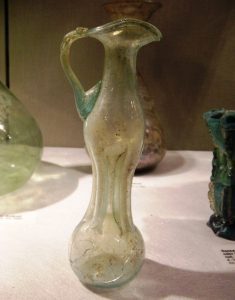Guttrolfe – Deutsch/German

Eine der wohl außergewöhnlichsten und rätselhaftesten Formen für Glasgefäße ist der Guttrolf. Der aus dem Lateinischen abgeleitete Name von „gutta“, der Tropfen, und „guttura“, die Kehle, erklärt den Zweck des Gefäßes: eine Flüssigkeit tropfenweise in die Kehle laufen lassen.
Die Guttrolfe des Glasmuseums sind das Herzstück der Sammlung. Sie bildeten in den 1940er Jahren den Anfang der Sammeltätigkeit des Museumsgründers Dr. Hans Löber. Die Gründung des Glasmuseums im Jahr 1976 geht auf ein fünfröhriges römisches Kännchen aus dem 3. oder 4. Jahrhundert zurück. Dessen Herstellungstechnik ließ dem Glasphysiker lange Zeit keine Ruhe. So entstand durch die Suche nach einer Lösung die wohl beachtlichste Guttrolf-Sammlung Deutschlands, mit über 30 Exemplaren aus verschiedenen Ländern vom 5. bis zum 19. Jahrhundert.
Mit dem Glasapparatebläsermeister Leonhard Macholdt aus Wertheim ließ Löber die alten, in Vergessenheit geratenen Glastechniken wieder aufleben. Dazu zählte auch das Blasen eines mehrröhrigen Guttrolfs an der Gebläselampe. Ausschlaggebend für die Lösung dieses technischen Problems war ein Dokument über die Glashütten im Spessart von 1405. Es beschreibt eine Tagesproduktion von 300 kleinen Bechern und 200 Guttrolfen. Diese große Stückzahl zu fertigen, war nicht durch die bisher vermutete aufwändige Verschmelz- oder Montagetechnik einzeln gefertigter Röhren möglich. Es musste eine einfachere Handhabung geben: Dabei wird ein rundes Rohr viereckig gestaucht. Durch Saugen anstatt Blasen fallen die Wandungen so ein, dass insgesamt fünf Röhren entstehen. Durch erneutes Erwärmen ist eine Verdrehung in der Form möglich, so dass man glaubt, fünf Röhren seien am Hals entstanden.
Guttrolf – English

One of the most exceptional and puzzling glass container shapes is known in German as a Guttrolf. The name is derived from the Latin „gutta“, meaning drop and „guttura“, meaning the larynx, which explains what it was used for: to allow liquid to flow drop by drop into the larynx.
The Guttrolfs in the museum of glass are the centrepiece of the collection. During the 1940s they are what inspired the museum founder Dr. Hans Löber to begin collecting glass. The foundation of the museum in 1976 goes back to a five-cylinder Roman jug dating from the third or fourth century. The glass physicist just couldn’t work out how it had been made and during his search for a solution he collected the most comprehensive Guttrolf collection in Germany, comprising over 30 examples from various different countries dating from the fifth to the 19th century.
In collaboration with the master glassblower for glass apparatus, Leonhard Macholdt from Wertheim, Löber revived the old forgotten glass production techniques. The ability to blow a several cylinder Guttrolf using a blowtorch was one of them and a document about the glass foundries in Spessart dating from 1405 was decisive in finding a solution to the technical problem. It describes a daily production of 300 small beakers and 200 Guttrolfs, which went against the complex smelting and mounting technique of the separate cylinders that had been supposed up until that point. So, there must have been a simpler way. A round cylinder can be squeezed together into a square shape, and the air is sucked out instead of being blown in which makes the walls of the glass fall together, so that altogether five cylinders are created. During reheating the shape of the glass can be contorted so that it looks as if five cylinders were created in neck.